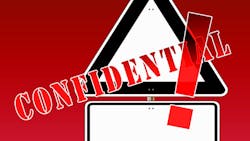The DTSA Should Add a Spark to Trade-Secret Enforcement
This file type includes high-resolution graphics and schematics when applicable.
The best protection for products that can be reverse-engineered is, of course, a utility patent. However, for aspects of a product that are not readily discerned from the product, such as manufacturing techniques, as well as hardware and firmware, the best protection is often trade-secret protection. What’s the biggest threat to those trade secrets? Typically, it’s the employees who know them.
Until recently, the protection of trade secrets was exclusively a matter of state law. But on May 11, 2016, President Obama signed the Defend Trade Secrets Act (DTSA), which took effect immediately. The DTSA amended the Economic Espionage Act (which provided criminal penalties for trade-secret misappropriation), giving the owners of trade secrets the right to enforce their trade secrets themselves by suing misappropriators.
DTSA Much Like the Uniform Trade Secrets Act
Substantively, the DTSA is very similar to the Uniform Trade Secrets Act (UTSA), some form of which is in effect in all states (except New York and Massachusetts), the District of Colombia, and Puerto Rico. The DTSA and UTSA use similar definitions of “trade secret” and “misappropriation,” and provide similar remedies of an injunction, compensatory damages, enhanced damages, and attorneys’ fees.
Under the DTSA, the trade-secret owner is entitled to an injunction “(i) to prevent any actual or threatened misappropriation” (18 U.S.C. §1836(b)(3)(A)(i)). The trade-secret owner is also entitled to an award of compensatory damages for actual loss caused by the misappropriation of the trade secret (18 U.S.C. §1836(b)(3)(B)(i)(I)), and any unjust enrichment caused by the misappropriation that’s not addressed in computing damages for actual loss (18 U.S.C. §1836(b)(3)(B)(i)(II)). Alternatively, damages can be awarded as a reasonable royalty for the unauthorized disclosure or use of the trade secret (18 U.S.C. §1836(b)(3)(B)(ii)).
Where the trade secret is willfully and maliciously misappropriated, the trade-secret owner may be awarded exemplary damages of up to two times the actual damages award (18 U.S.C. §1836(b)(3)(C)) and an award of attorneys’ fees (18 U.S.C. §1836(b)(3)(D)). However, the award of attorneys’ fees is a two-edged sword, and the trade-secret owner could be liable for attorneys’ fees if a claim of the misappropriation is made in bad faith, or a motion to terminate an injunction is opposed in bad faith (18 U.S.C. §1836(b)(3)(D)).
Improvements Made by the DTSA
The DTSA provides several small but significant improvements to UTSA protection.
First, the DTSA creates a federal cause of action for trade-secret misappropriation. Presumably, a federal statute has a greater geographic scope (both in terms of actions and actors covered) than state law claims under the UTSA. The original Economic Espionage Act (18 USC §1837), which would appear to apply to private actions under the DTSA, makes U.S. persons and entities liable for trade-secret misappropriation that occurs abroad, and makes any person or entity liable if an act in furtherance of the offense was committed in the United States. Thus, the DTSA provides protection not only against U.S. employees, but foreign employees who commit an act in the United States (such as accessing a U.S.-based server)
Second, the DTSA gives the trade-secret owner access to federal courts, valued by litigators because they’re generally faster and more consistent than state courts. Prior to the DTSA, a state misappropriation claim could only be brought in federal court if there was some independent basis for federal jurisdiction. Examples include supplemental jurisdiction when there was a related federal claim, or diversity jurisdiction where the parties are from different states. However, federal jurisdiction is not exclusive, leaving open the possibility of bringing a DTSA claim in state court if that’s procedurally advantageous to the trade secret owner
Because the majority of trade-secret claims are by employers against former employees, this type of employment litigation may be moving to Federal Court. In fact, one of the first lawsuits brought under the act, Universal Protection Services v. Thornburg, filed in the Northern District of Texas just eight days after the DTSA was signed, was brought by an employer against a former employee. Federal jurisdiction may be particularly beneficial in the electronics industry, with its highly mobile and increasingly international workforce.
Third, the DTSA provides the extraordinary remedy of an ex parte civil seizure, providing for the seizure of property necessary to prevent the propagation or dissemination of the trade secret. The procedure is complex to provide safeguards for both the trade-secret owner and the target of the seizure order, but allows for action without tipping off the misappropriator. The type of manufacturing data, schematics, and software and firmware important in the electronics industry is readily transmitted, so a seizure may be the only way to recover it.
For individual misappropriators, like former or existing employees who likely cannot pay a large damage award, recovering the trade secret may be the only effective remedy obtainable by trade-secret owner. However, the trade-secret owner must be careful because the DTSA gives a cause of action to anyone who suffers damage by reason of a wrongful or excessive seizure.
Existing State Law Protection Remains Unchanged
A significant aspect of the DTSA is that it leaves intact existing state law protections for trade secrets—it adds a new layer of protection rather than replace existing protection. This is important because the DTSA is neutral on the Inevitable Disclosure Doctrine, which allows the trade-secret owner to prove misappropriation by showing that the defendant’s new employment will inevitably lead to the disclosure and use of the trade secrets.
The Inevitable Disclosure Doctrine has been rejected in some states (e.g., California), and the DTSA purposely doesn’t introduce the Doctrine to those states that have rejected it, prohibiting injunctions that “conflict with an applicable State law prohibiting restraints on the practice of a lawful profession, trade, or business” (18 U.S.C. § 1836(b)(3)(A)(i)(II)).
While the DTSA prohibits injunctions based “merely on the information the person knows” (18 U.S.C. § 1836(b)(3)(A)(i)(I)), it doesn’t prohibit the Inevitable Disclosure Doctrine, which requires an additional showing that the disclosure is in fact inevitable. Thus, where the Inevitable Disclosure Doctrine does apply, it’s still available to trade-secret owners under state law.
Another benefit of the survival of state trade-secret law stems from the DTSA’s conditioning of awards of enhanced damages and attorneys’ fees based on the trade-secret owner providing notice of the immunity for certain disclosures of trade secrets by whistleblowers in any “contract or agreement with an employee that governs the use of a trade secret or other confidential information.” “Employee” in this context includes any individual performing work as a contractor or consultant for an employer.
Employers should include this notice in all employee new agreements, and amendments to existing agreements after May 11, 2016. If an employer fails to do so, the enhanced damages and attorneys’ fees unavailable under the DTSA may still be available under a state law claim.
The DTSA—A Nice Supplement to Existing Trade-Secret Protection
There are several reasons why the DTSA is a beneficial supplement to existing state law protection for trade secrets:
• It creates a federal cause of action that gives the trade-secret owner access to federal courts, supplying the trade-secret owner with additional options to combat trade-secret misappropriations.
• It provides better extraterritorial reach to actions by U.S. persons and entities abroad, and actions by anyone if an act in furtherance of the offense was committed in the United States.
• It provides for ex parte civil seizure to physically remove the trade secret from the hands of a misappropriator.
• It leaves intact state law remedies, including the Inevitable Disclosure Doctrine, protecting trade-secret owners from defecting employees.
The only downside for trade secrets is that a trade-secret owner must include a notice of immunity in any confidentiality agreement with employees, and individual contractors and consultants after May 11, 2016. However, this can be conveniently incorporated into the agreement, or by a cross-reference to a policy document given to the employee. Even if the employer fails to provide the required notice, the trade secret is not lost; rather, the remedies are simply limited, and these remedies may still be available under state law.
While there’s nothing shocking in the DTSA, it does provide a spark for the enforcement of trade secrets. This is particularly beneficial for the electronics industry, where the trade secrets are so readily stored and transported, and the workforce is so highly mobile and international.
Looking for parts? Go to SourceESB.
This file type includes high-resolution graphics and schematics when applicable.
About the Author
Bryan Wheelock
Principal
Bryan Wheelock is a registered attorney admitted to practice before the U.S. Patent & Trademark Office. His practice includes the preparation and prosecution of patent and trademark applications and drafting of intellectual-property agreements, including non-compete agreements. He has brought and defended lawsuits in federal and state courts relating to intellectual property, and participated in seizures of counterfeit and infringing goods. Bryan is a Principal at Harness, Dickey & Pierce.


